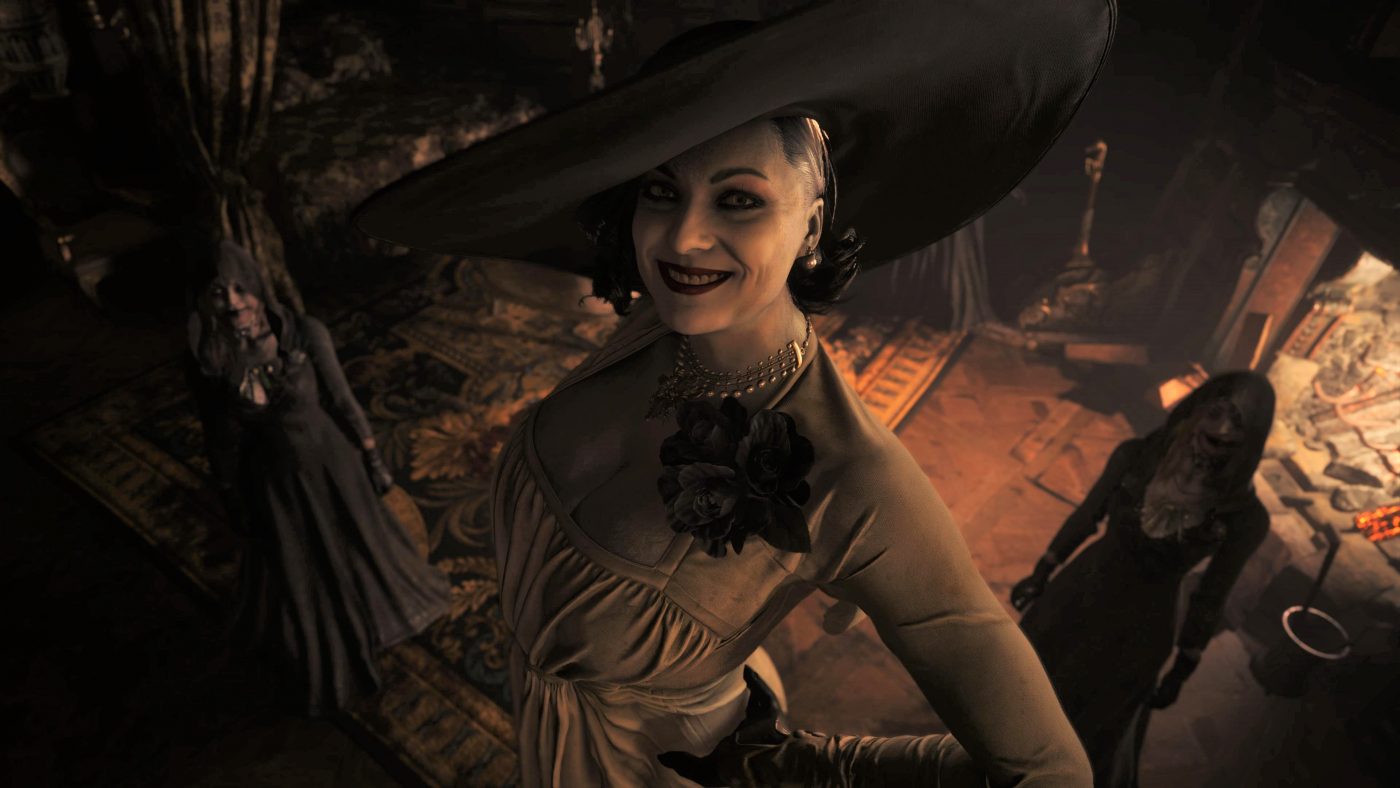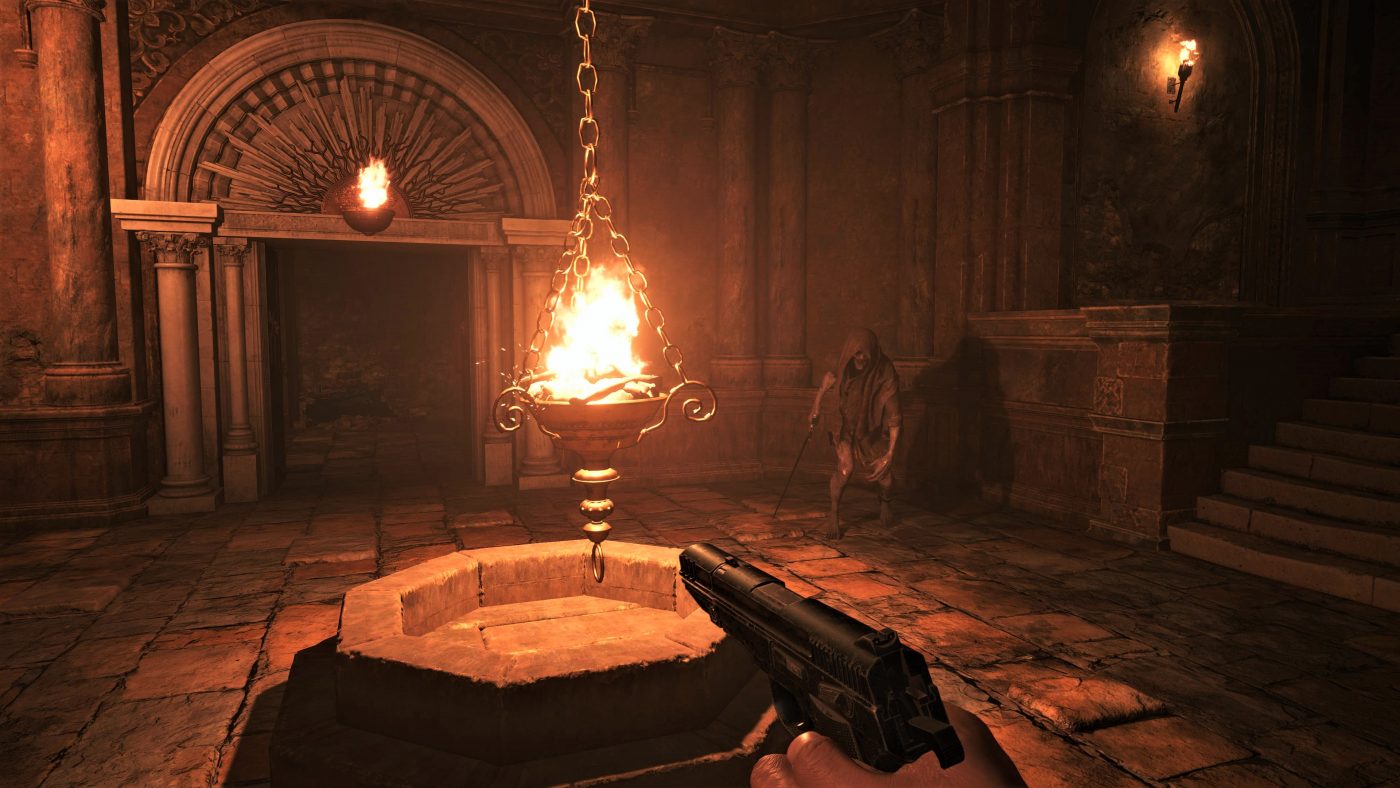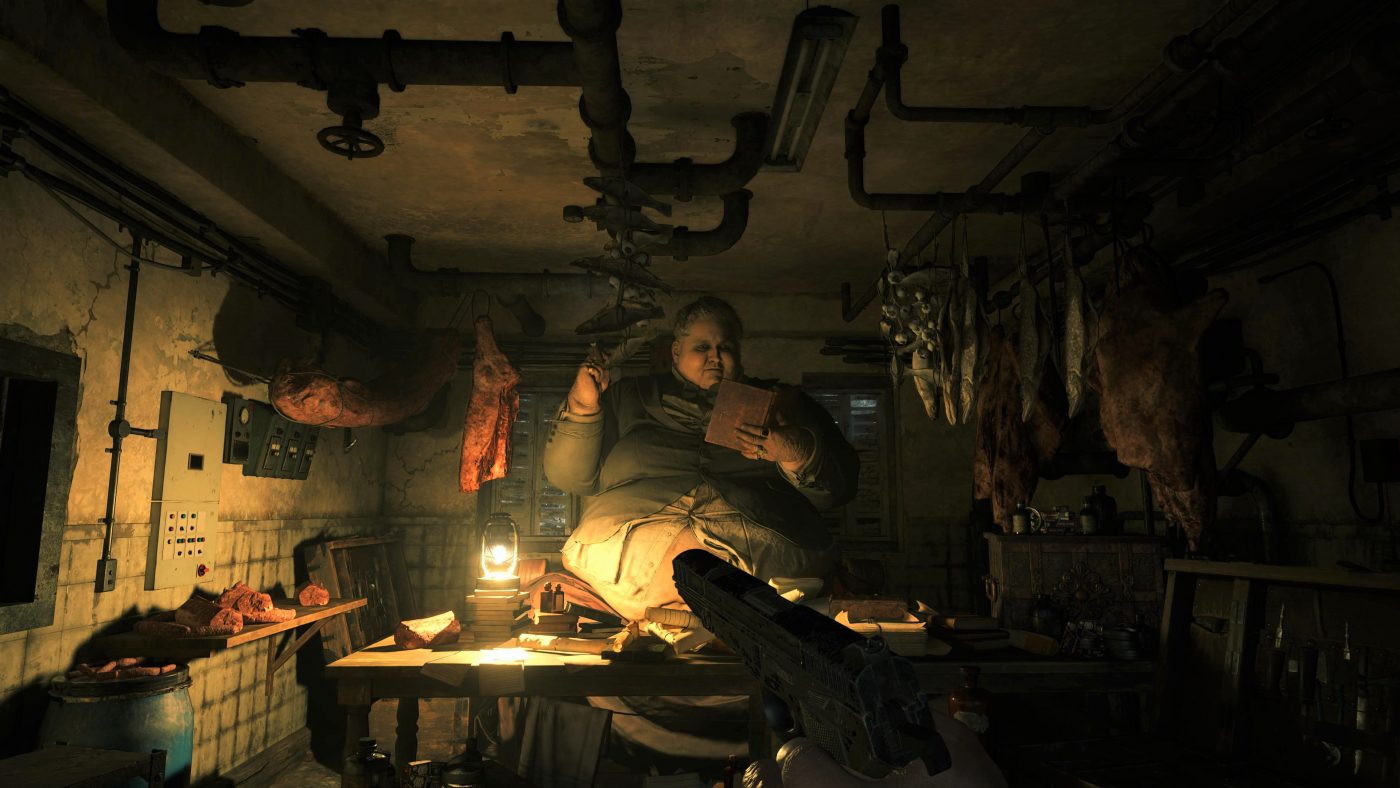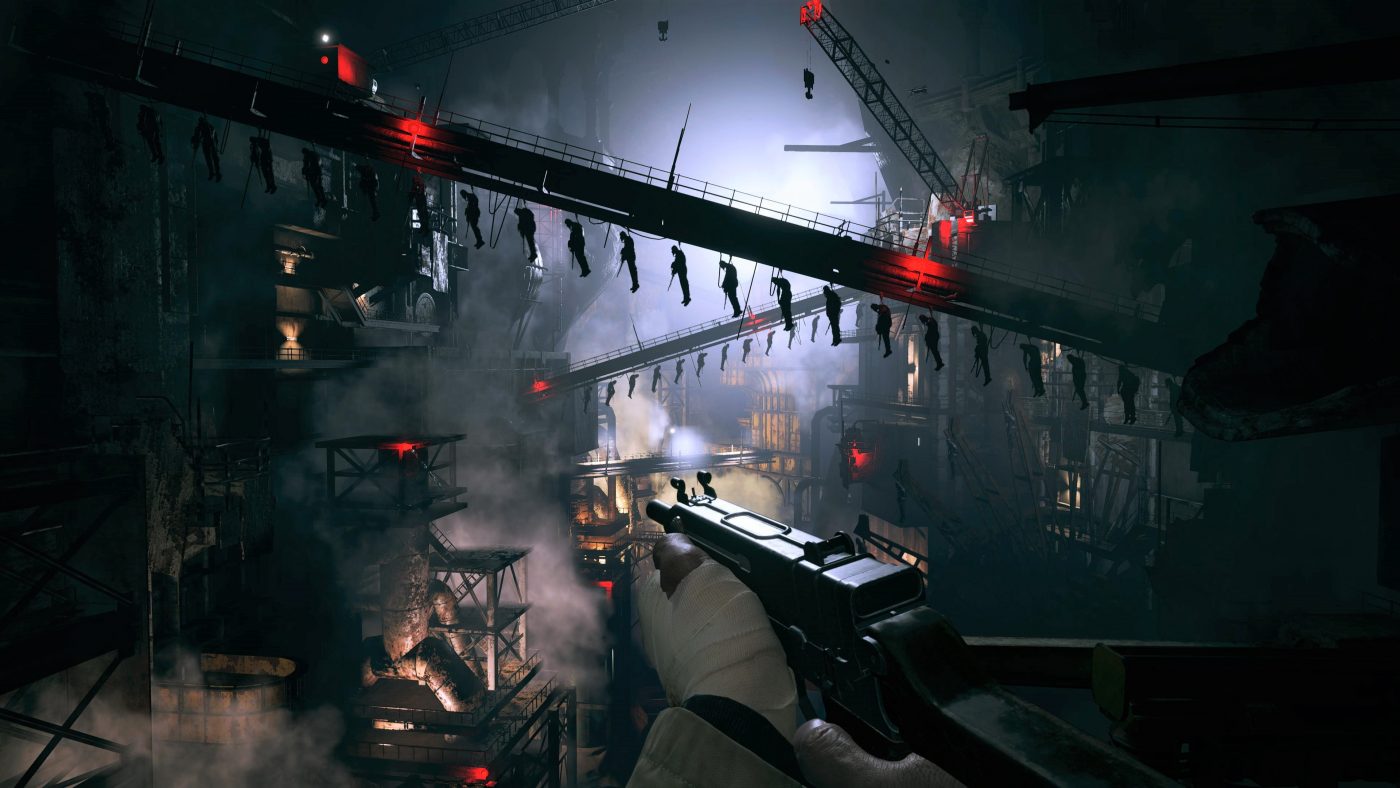–
There’s a bit early on in Resident Evil Village when Ethan Winters, the recurring player character from 2017’s Resi 7, gets his hand chopped off. In a grim (yet beautifully-realised) cutscene, you watch in bewildered horror as his wrist slides slowly away from his still-clenched fist in a fountain of blood. It’s a horrifying and shocking moment that brilliantly succeeds in emphasising both your vulnerability and the inhuman ruthlessness of your enemies. Or it would be, at least, if it weren’t for the fact that, two minutes later, you pick up your severed mitt, plonk it back on the bloody stump of your wrist, slosh some magic water over it and then go on your merry way, hand seemingly as good as new.
As well as being absolutely hilarious, this sequence encapsulates the game’s darkly comic tone perfectly. While 7’s isolated southern fried setting and cannibalistic family of murderous hillbillies leavened its grimness with a heavy touch of the absurd, Village turns the goofiness up to eleven and creates something that feels more Hammer Horror by way of The Evil Dead and its sequels. Over the course of an eleven hour campaign, its more preposterously silly moments (of which there are several, most involving Ethan getting grievously injured) had me snorting aloud in stunned disbelief. While, overall, I think (or perhaps hope) this ridiculousness was by design and not chance, it’s to Capcom’s credit that they never go quite so far as to drop the audience a knowing wink and give the game away.

This change in tone compared with 7 comes with a change in setting, too. Three years on from Ethan’s run-in with the Bakers, he and newly-rescued spouse Mia have upped sticks and moved to central Europe. The game begins with you putting your infant daughter, Rose, down for the night, but it’s not long before everything goes very wrong and you’re given an excuse to explore the titular hamlet and its surrounding environs. A mysterious and – this time – explicitly supernatural gang of freaks have kidnapped baby Rose for some nefarious purpose. With Mia out of the picture, it’s up to beleaguered dad Ethan to save the day once more. ‘Why the fuck is this happening again?!’ he exclaims in an early cutscene. Bless him.
The village itself serves as a hub that you set out from and then return to over the course of the game, Capcom revisiting a structure they haven’t used in a mainline Resi since REmake on the Gamecube. In a clever piece of design, you’re given a whistle-stop tour of the village through an intense introductory sequence that harks back to the harrowing opening to Resi 4, right down to the bookcases you can use to blockade doors and windows. From there, however, much of the village becomes gated off. This allows the developers to bring in some light metroidvania-ish gameplay as you gradually reopen areas using the keys you pick up from your forays into the four different areas that break away from the village itself.

The first of these domains, the magnificently baroque Castle Dimitrescu, home to the statuesque Lady of the same name, is the best. As you creep around its opulent halls, opening secret passageways and collecting unlikely puzzle pieces in a typically silly Resident Evil fashion, you’re put in mind of some of the more memorable locations from previous games in the series: the Spencer Mansion, Racoon City Police Station, Salazar’s fortress – all are referenced here. From basement dungeon to rooftop garret, every room in the castle is rendered in impeccable detail, Capcom setting a new standard with their already impressive RE Engine. The lighting (my God, the lighting), here and elsewhere, is especially worthy of praise. Flickering braziers throw up dancing shadows against papered walls while bare bulbs cast dingy corridors in a sickly hue. Playing on PlayStation 5 with ray-tracing turned on, it’s a sight to behold. The audio design is similarly outstanding. Lady Dimitrescu’s heavy tread is perhaps even more hair-raising here than Mr X’s relentless footsteps were in 2019’s Resident Evil 2. And an encounter later on uses sound to such a disturbingly effective degree that it’s difficult to keep your headphones on.
When you do come face-to-face with enemies, combat is thankfully improved from 7. There is greater enemy variety and better manoeuvrability. A weapon upgrade system lifted straight from Resi 4 encourages you to track down every single treasure you can to fund your need for increased firepower as the stakes get higher. This time around, your bread and butter enemies are the lycans, half-transformed, Bloodborne-esque werewolves who scurry towards you, ducking and weaving out of the way of your weedy pistol shots, vaulting up sheer walls in a heartbeat. Capcom pitches you against these foul beasts, and their variants, in increasingly higher numbers as the hours clip by, forcing you to cycle between weapons, craft ammunition on the fly, prioritise certain foes over others and make the most of bottlenecks in the environment. From beginning to end, every enemy encounter is tense and the illusion of ammo scarcity is enough to make you feel pressured into picking your shots with caution.

This isn’t quite enough to prevent repetition from settling in later on, however. If anything, I could have done with even more combat options, especially when it came to close-quarter encounters. Apart from a half-hearted shove you can only pull off once you’ve blocked an attack, there’s no option to attack enemies without using bullets except for your knife, which is so ineffective it’s hardly worth the effort. For all Village borrows from Resident Evil 4, the absence of a button that lets you deliver a swift roundhouse kick to the face was keenly felt at times.
Unfortunately, this sense of a missed opportunity was something I experienced elsewhere, too. Capcom appears in such a rush to keep you moving that levels come to an end just as they seem to get going, before the tension has had a proper chance to brew. A P.T.-inspired second area starts off promisingly but is ultimately anticlimactic in its brevity. Resi 4’s memorable action set-pieces are replaced with barely interactive chase sequences that feel like QTEs in disguise, punishing you with insta-death if you can’t figure out exactly what it is the game wants you to do quickly enough. Puzzles are condescendingly, laughably simple, even by Resi’s standards, while the (sometimes literal) signposting and spoon-feeding means you never truly have to engage your brain. There’s definitely something to be said for dropping an idea before it gets stale, but parts of Village feel distinctly half-baked.

In the end, it’s not that the game is too short, because it isn’t, and I’m all for narrative-led single-player experiences that can be completed over a weekend. Rather, it’s depth that’s lacking here, and my lasting impression upon completing Resident Evil Village was of a game that was superficial and, at times, simplistic enough to not feel a million miles away from the VR experience that defined its predecessor. To be sure, it’s spectacular, expensive and, for the most part, good gory fun, though there’s also a hollowness to it that stops it short of greatness. I enjoyed my time with it, especially its opening hours, but for as much as it plays the hits from Resident Evils of days past, ultimately it left me wanting.

